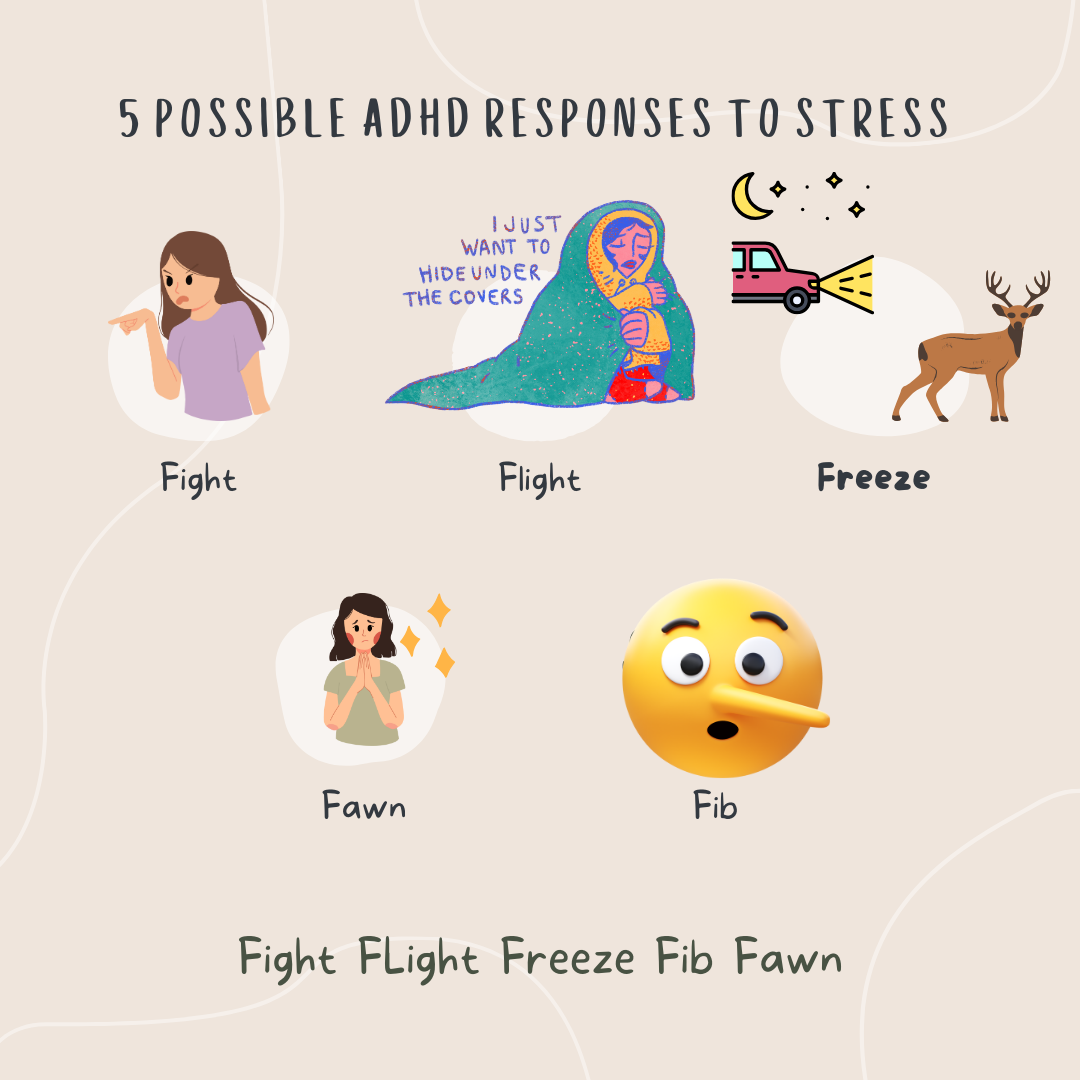
Understanding the ADHD Fight or Flight Response
Are you struggling with heightened stress or anxiety in your daily life? As someone with attention Deficit Hyperactivity Disorder (ADHD), you might find that the fight or flight response is more intense, making everyday challenges feel overwhelming. Understanding and managing this response can lead to a happier, more balanced life.

The fight or flight response is a natural reaction to perceived threats. It prepares our bodies to either confront or flee from danger. For women with ADHD, this response can be especially pronounced, often leading to increased stress and anxiety. Recognizing and managing this response is essential for maintaining emotional well-being and overall happiness.
Understanding Stress Responses
Five Responses to Stress
When faced with stress or perceived danger, your brain may activate one of five survival responses. Let's take a look at them:
- Fight: Confronting the threat.
- Flight: Escaping the threat.
- Freeze: Becoming immobilized or numb.
- Fawn: Trying to please others to avoid conflict.
- Fib: Fabricating stories to avoid immediate negative consequences, often developed as a coping mechanism in children with ADHD.

Development of Stress Responses in Childhood and the Fib Response
The development of stress responses, such as fight, flight, freeze, fawn, and fib, often begins in childhood. Children who grow up in environments where they frequently feel unsafe or unsupported may develop these responses as survival mechanisms.
For instance, a child who experiences consistent criticism or unpredictability may learn to fawn, seeking approval to avoid conflict. Similarly, a child exposed to frequent threats may develop a strong flight response, always ready to escape perceived danger.
Additionally, children with ADHD might develop the fib response to cope with frequent misunderstandings, miscommunications, and the struggle to meet expectations of adults and parents.
When faced with the possibility of disappointing others or facing punishment, they might fabricate stories to avoid immediate negative consequences. This can be a way to manage the anxiety and stress that come with the challenges of ADHD in a neurotypical world. Understanding these responses as protective mechanisms can lead to more compassionate strategies for supporting individuals, especially children with ADHD, fostering a supportive environment.
Adults and parents need to stop relating to ADHD children in a way that creates a fear of judgment, mistakes, and shame. The constant pressure and criticism make their brain and nervous system feel under attack, priming ADHD children for a heightened fight or flight response. This heightened state of alertness can persist into adulthood, leading not only to chronic stress and anxiety but also to other stress responses such as rejection-sensitive dysphoria (RSD), avoidance, freeze, and people-pleasing behaviors.
These patterns can severely impact their self-esteem, relationships, and professional lives, as they constantly seek to avoid conflict or be on the defensive. Understanding and addressing these responses early on can help foster a healthier, more supportive environment for ADHD children, promoting better long-term emotional and mental well-being.
Recognizing these patterns can be the first step in learning to manage and transform these responses into healthier coping mechanisms.
Learning the Triggers for the Fight Flight Response in ADHD
- Recognizing and Identifying Your Stress Response
Understanding your fight or flight response starts with recognizing the signs and triggers. Here are some steps to help you identify your response:
- Physical Symptoms: Pay attention to physical changes such as increased heart rate, sweating, shallow breathing, or muscle tension. These are common sources of information that the fight or flight response is beginning.
- Emotional Reactions: Notice your emotions in response to a situation or event. Feelings of anxiety, fear, anger, or irritability can signal that your stress response is activated. All of these emotions can be perceived as a threat and can cause you to go into your stress response.
- Behavioral Changes: Observe any changes in your behavior, such as avoidance, aggression, or impulsivity. These behaviors can be a reaction to perceived threats.
- Thought Patterns: Be mindful of your thoughts. Catastrophic thinking, excessive worry, or a sense of impending doom can accompany the fight or flight response.
- Identify Triggers: Reflect on situations or events that consistently trigger your stress response. As an adhd person, even seemingly innocuous situations can be perceived by your nervous system and brain as threats. For example, anything that puts stress on the adhd brain can trigger threats. Understanding these triggers can help you anticipate and manage your reactions. Projects that heavily tax your working memory, require advanced executive functioning skills, or demand meticulous time management and organization can put significant stress on your brain, especially if these are not your strengths. This stress can trigger your brain's fight-or-flight response, making it harder to focus and perform effectively.
By becoming more aware of these signs and triggers, you can take proactive steps to manage your fight or flight response, leading to greater emotional well-being and resilience.
Gaining insight into your fight or flight response and actively working to manage it can help you cultivate emotional well-being, resilience, and a greater sense of happiness in your daily life. Remember, you are not alone on this journey. Embrace your ADHD, understand your unique responses, and thrive.
Learn some more about stress here
Strategies for Managing Your Response
Emotional Regulation
Improving emotional regulation starts with understanding your fight or flight response. By identifying what triggers this response and learning how to manage your reactions, you can reduce the impact of stress on your mood. Techniques such as mindfulness, relaxation exercises, and positive reframing can help you navigate stressors more effectively.
Improved Coping Strategies
Awareness of your fight or flight response enables you to develop effective coping mechanisms. Whether through therapy, medication, or self-help strategies, finding what works best for you is crucial. Consistency and self-compassion are key in building resilience and reducing the impact of stress on your well-being.
Enhanced Self-Awareness
Understanding your fight or flight response can deepen your self-awareness. This insight allows you to recognize your behaviors, thought patterns, and triggers, empowering you to make conscious choices that align with your values and goals. Greater self-awareness can lead to a more fulfilling and balanced life.
Reduced Anxiety and Overwhelm
Managing your fight or flight response can significantly reduce feelings of anxiety and overwhelm. By implementing stress-reducing techniques and setting boundaries, you can create a more harmonious lifestyle that promotes happiness and well-being. Remember, it's a gradual process that requires patience and self-compassion.
Improved Relationships
Understanding your stress response can enhance your communication and interactions with others. By managing your fight or flight reactions, you can respond more thoughtfully in relationships, fostering understanding, empathy, and connection with those around you. This can lead to stronger, more supportive relationships.
Increased Resilience
Developing strategies to regulate your fight or flight response builds resilience in the face of adversity. This resilience helps you bounce back from challenges, adapt to change, and maintain a positive outlook. Ultimately, this contributes to a greater sense of happiness and fulfillment.
Practical Tips for Managing the ADHD Fight or Flight Response
Mindfulness Practices: Engage in mindfulness exercises such as deep breathing, meditation, or yoga. These practices can help you stay present and calm, reducing the intensity of your fight or flight response.
Physical Activity: Regular physical activity, like walking, running, or dancing, can help reduce stress hormones and improve your mood. Find an activity you enjoy and make it a part of your routine.
Healthy Boundaries: Learn to set and maintain healthy boundaries in your personal and professional life. This can help protect your well-being and prevent burnout.
Therapeutic Support: Consider seeking therapy or joining support groups. Sharing your experiences and gaining insights from others can be incredibly beneficial.
Self-Compassion: Practice self-compassion by being kind to yourself. Acknowledge that managing stress is a journey, and it's okay to have setbacks. Celebrate your progress, no matter how small.
Medications for Managing Stress Response
Medications that help manage ADHD can also impact the fight-or-flight response, as they often improve overall emotional regulation and reduce hyperactivity and impulsivity. The primary medications for ADHD fall into two main categories: stimulants and non-stimulants.
- Stimulants: These are the most commonly prescribed medications for ADHD and are effective for many individuals. They work by increasing the levels of certain neurotransmitters in the brain, which helps improve attention and focus and can indirectly aid in regulating the fight-or-flight response.
- Methylphenidate-based medications (e.g., Ritalin, Concerta)
- Amphetamine-based medications (e.g., Adderall, Vyvanse)
- Non-stimulants: These may be prescribed when stimulants are not effective or cause significant side effects. They can also help with emotional regulation and managing stress responses.
- Atomoxetine (Strattera): A norepinephrine reuptake inhibitor that helps increase attention and decrease impulsivity and hyperactivity.
- Guanfacine (Intuniv) and Clonidine (Kapvay): Alpha-2 adrenergic agonists that can help with hyperactivity, impulsivity, and emotional regulation.
These medications can help individuals with ADHD manage their fight-or-flight response by improving their ability to focus, reducing impulsivity, and enhancing overall emotional regulation. However, the effectiveness and side effects of these medications can vary from person to person, so it's essential to work closely with a healthcare provider to find the best treatment plan.
CBT strategies to Help ADHD people with Stress Response
- Mindfulness: Practice staying present with deep breathing, meditation, and body scans to recognize and calm the fight-or-flight response.
- Exposure Therapy: Gradually face stressful situations in a safe way to reduce fear over time.
- Cognitive Restructuring: Challenge and change negative thoughts to reduce anxiety.
- Relaxation Techniques: Use deep breathing, progressive muscle relaxation, and calming imagery to reduce stress.
- Biofeedback: Use technology to learn how to control physical stress responses like heart rate and muscle tension.
- Stress Inoculation Training: Learn and practice coping skills to handle stress better.
- Acceptance and Commitment Therapy (ACT): Accept stress and focus on actions that align with your values.
- Dialectical Behavior Therapy (DBT): Use skills to manage emotions and handle distress.
Addendum: All these techniques should be modified to suit the unique needs of neurodivergent individuals to ensure effectiveness and comfort.


